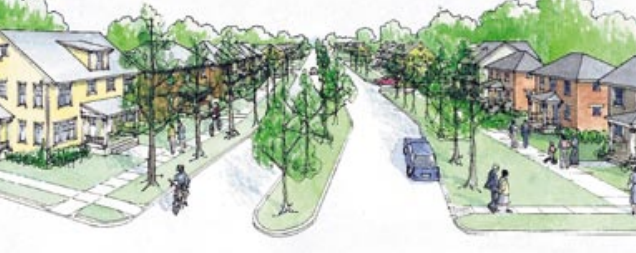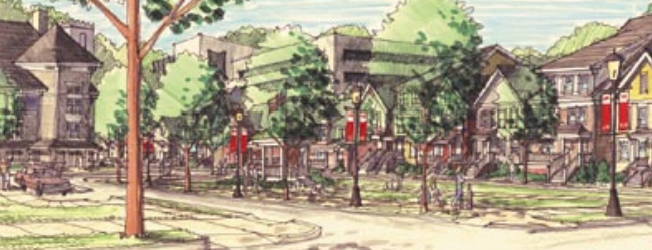Youngstown 2010 Plan
Chapter 8: Implementation
The City of Youngstown has experienced both the prosperity of the steel industry with census data showing its highest per capita family income locally (adjusted for inflation) achieved in 1960 to the devastating results of deindustrialization with huge population and jobs losses since the 1970s. The City has been drifting along ever since without any real direction until now. Youngstown 2010 has reignited the community civic pride and set a new direction for development in Youngstown.
This new direction is not without difficult choices or long term commitments. Individual projects and decisions must conform to the new Youngstown 2010 Citywide Plan. More detailed neighborhood plans are encouraged to be undertaken by residents, organizations and businesses in each of the 31 neighborhoods in the city, similar to the Smoky Hollow neighborhood.
The City of Youngstown is only a partner in the revitalization of the community and is not the sole responsible entity. Government, business, institutions and the community working together is the only way Youngstown has a chance of a sustainable future. It’s our future, get involved!
Government, business, institutions and the community working together is the only way Youngstown has a chance of a sustainable future.
Next Steps
During the planning process from the visioning sessions, the presentations and the neighborhood meetings, careful attention was given to the comments of the participants as to their views on projects that would make Youngstown a more desirable place to live. They were specifically asked for projects that could reasonably be expected to be underway or completed
by 2010.
The City can, by enacting and enforcing design standards consistent with the Youngstown 2010 Vision and Plan, jump start the process towards implementation. As the new zoning ordinance is composed and enacted, these design standards will be folded in helping to ensure that early implementation projects will not divert from the principles and themes in the Vision and Plan.
The City cannot afford single handedly do all that this plan calls for on its own. This will take a collaborative effort between the City, citizens, private sector developers and businesses, Youngstown State University, Youngstown Board of Education, community development corporations, other government agencies, religious entities, etc.
Cleaner
- Carry out annual major thoroughfare/gateway cleanup
- Convert surplus school building sites to green space
- Coordinate beautification/enhancement projects with
- Ohio Department of Transportation (ODOT) on all applicable projects
- Target highly visible demolitions
- Seek EPA waiver for accelerated citywide demolitions
- Seek Clean Ohio funding for Brownfields remediation
- Study/Implement code enforcement
- Establish a housing court
- Create joint code enforcement districts
- Hold property owners accountable
Greener
- Create and maintain high quality city parks
- Extend Crandall Park to Crab Creek
- Redesign Wick Park and increase usage through YSU partnership
- Establish new parks in strategic neighborhood locations
- Naturalize Crab Creek
- Enhance Wirt Street with landscaped media
Better Planned and Organized
- Encourage organizations to develop neighborhood plans
- Establish Industrial Green Districts
- Revitalized priority business centers
- Support planned redevelopment with City Planning Commission approval
- School and Library Investment Districts
- Mahoning River Corridor of Opportunity
- CHOICE/Jubilee – Commonwealth – South Side Community Development Corp. – North Side Citizens’ Coalition
- Convert select city parks to new land uses
- Reorganize Streetscape Committee as Cityscape
- Improve the City Land Bank Program
- Dedicated Land Bank Coordinator
- Targeted land bank acquisitions
- Expand the Renewal Community District
- Adopt new zoning code with new development design standards
- Complete citywide & regional economic studies
- Seek grant funding opportunities to leverage projects
- Establish efficient traffic coordinating system
- Partner with Neighboring Communities
- Campbell: Joint Services – Green Network Linkage
- Austintown: Meridian Road Industrial District – Green Network Linkage
- Boardman: Common Border Districts – Green Network Linkages
- Liberty: 711 Connector/Gypsy Lane/Belmont Avenue Joint Development Opportunities – Common Border Districts – Green Network Linkages
- Struthers: Common Border Commercial Districts – Green Network Linkages
- Coitsville: Common Border Issues – Preserve Green Space
- Girard: 711 Connector Development Opportunities – Common Border Districts – Green Network Linkages
- Hubbard: Hubbard Arterial Project – Common Border Districts – Green Network Linkage
- Weathersfield: Common Border Districts – Green Network Linkages
- Support Education and Job Creation Incentives
- Mahoning River Education Project
- Mahoning Valley Vision for Education
- Urban Congress
- Steel to Scholars
- NEO – Healthforce
- Support Regional Infrastructure Projects
- Hubbard Arterial
- 711 Connector
- Youngstown – Warren Regional Airport – SOAR
- Regional Rail Passenger Service
- Regional Hike/Bikeway Investments
North Side Next Steps
Throughout the neighborhood meetings, a list of projects that could be undertaken by 2010 that would have an immediate impact on the City was gathered, and fit into three categories; cleaner, greener and better planned and organized. Many of these have citywide ramifications. Those most directly related to the North Side are:

Cleaner
- Carry out annual major thoroughfare/gateway cleanups on:
- Belmont Avenue
- Fifth Avenue
- Gypsy Lane
- Wick Avenue
- Logan Avenue
- Convert surplus school buildings to green space
- Hayes Middle School
- Coordinate beautification/enhancement projects with Ohio
Department of Transportation (ODOT) on:
- Madison Avenue Expressway
- McGuffey Bridge/Andrews Avenue
- Target residential demolitions in stable neighborhoods, planned areas or adjacent to catalyst projects/neighborhood assets
- Target residential rehabilitation funding in stable neighborhoods, planned areas or adjacent to catalyst projects/neighborhood assets
- Remediate YBM property
Greener
- Create and maintain high quality city parks:
- Extend Crandall Park to Crab Creek
- Redesign Wick Park and increase usage through YSU Partnership
- Establish new parks in strategic neighborhood locations
- Naturalize Crab Creek
- Enhance Wirt Street with landscaped median
Better Planned and Organized
- Encourage organizations to develop neighborhood plans
- Brier Hill
- Wick Park
- North Heights
- Establish Industrial Green Districts in:
- Wick Avenue/Logan Avenue/Andrews Avenue
- 711 Connector/north Brier Hill
- Revitalize priority business centers at:
- 711 Connector
- Belmont Avenue/Gypsy Lane
- Belmont Avenue/Catalina Avenue
Central District Next Steps
Throughout the neighborhood meetings, a list of projects that could be undertaken by 2010 that would have an immediate impact on the City was gathered, and fi t into three categories; cleaner, greener and better planned and organized. Many of these have citywide ramifi cations. Those most directly related to the Central District are:

This resource is an abridged version of the Youngstown 2010 plan. You can access the full version in pdf format below.